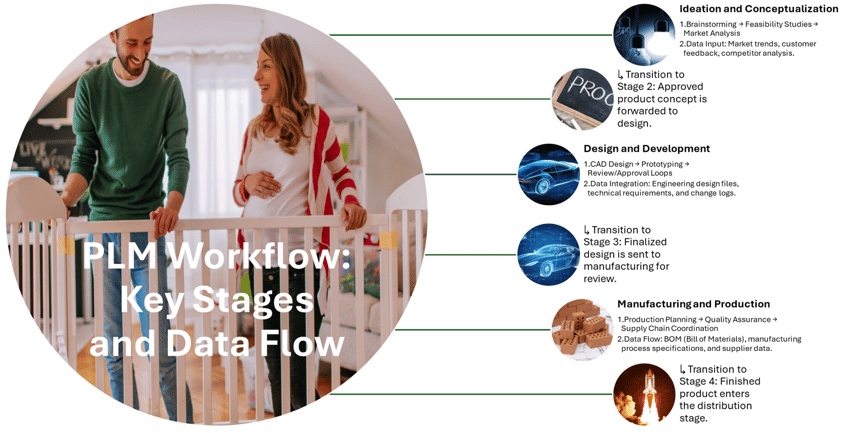Delivering Successful IT Projects for over 20 years
Product Lifecycle Management
Bringing your Product to Life!
End to End Product Portfolio Management




Driving Innovation From Concept to Implementation
Taking an idea from concept to implementation requires a structured Project Portfolio Management (PPM) approach. This ensures that ideas are validated, refined, and aligned with organizational goals before moving into the RFP and estimation stages. Here's how the process unfolds:
A) Need Assessment and Validation
Collect Ideas: Begin by sourcing ideas from stakeholders, brainstorming sessions, or customer feedback.
Evaluate Feasibility: Use a scoring framework to assess each idea based on criteria such as business impact, cost, and alignment with strategic objectives.
Stakeholder Alignment: Present high-priority ideas to key stakeholders for input and approval to proceed.
PPM Role: Organize and standardize the evaluation process to ensure data-driven decisions.
B) Define Use Cases, Goals, and Actions
Develop Use Cases: Outline how the proposed solution will function in real-world scenarios. For example, a PLM system might streamline design approvals or enhance version control.
Set Goals: Define clear objectives the project must achieve, such as reducing time-to-market or improving data accuracy.
Map Actions: Create a workflow or action plan detailing steps to implement the solution, from data integration to user training.
PPM Role: Facilitate workshops and documentation to capture use cases and ensure alignment with organizational priorities. HINT: Collecting the usecases are critical activities as it helps catpure GAPS and options
2. Develop the RFP
The Request for Proposal (RFP) process sets the foundation for selecting the right vendor and solution.
Define Requirements: Collaborate with stakeholders to document technical and business needs in detailed specifications, such as Technical Requirements Documents (TRD) and Business Requirements Documents (BRD).
Create Use Cases: Define specific scenarios and workflows the solution must support, such as version management, data integration, and approval processes.
Distribute RFP: Send the RFP to a shortlist of vendors who align with your organization's needs and goals.
PPM Role: Project teams oversee stakeholder alignment, ensuring all requirements are captured and reflected in the RFP.
3. Vendor Evaluation
Selecting the right vendor is critical to success and begins with analyzing RFP responses.
Scoring Matrix: Create a weighted scoring system based on key criteria like scalability, functionality, integration, and cost.
Demonstrations and Testing: Invite vendors to showcase their solutions and evaluate their fit through hands-on demonstrations and sandbox trials.
Stakeholder Input: Collect feedback from key departments (e.g., engineering, IT) to ensure buy-in.
PPM Role: Provide an objective framework for evaluation and facilitate consensus among stakeholders.
4. Software Selection and Negotiation
Once a vendor is chosen, the focus shifts to finalizing agreements.
Benchmarking the Solution: Validate the selected software against key performance indicators (KPIs) such as usability, efficiency, and compatibility.
Negotiate Terms: Secure agreements on timelines, costs, and support services.
PPM Role: Drive negotiations and ensure the selected solution aligns with organizational strategies and budgets.
5. IT Roadmap & Implementation Strategy
Develop a detailed implementation roadmap outlining milestones, deliverables, and timelines.
Implementation Phases: Divide the project into stages, such as setup, customization, testing, and rollout.
Allocate Resources: Assign teams, set budgets, and establish clear roles and responsibilities.
PPM Role: Create a centralized roadmap that aligns with organizational priorities and ensures resource optimization.
6. Implementation Planning
A structured plan ensures a smooth transition from selection to execution.
Workflow Design: Map existing workflows into the new system and make adjustments to accommodate enhanced capabilities.
Integration Points: Identify how the solution will connect with existing tools, such as ERP, PIM, or reporting platforms.
Training Plans: Develop a strategy to onboard teams and provide hands-on training sessions.
PPM Role: Monitor progress and maintain alignment with the roadmap.
7. Execution and Monitoring
This is the critical phase where the solution is implemented and its success is measured.
Pilot Rollout: Begin with a small-scale deployment to identify issues and gather user feedback.
Full Deployment: Roll out the solution across the organization, addressing any challenges promptly.
Real-Time Monitoring: Use dashboards and analytics to track key metrics such as user adoption rates, project milestones achieved, and system performance.
PPM Role: Ensure adherence to timelines, track metrics, and make necessary adjustments to address issues.
8. Post-Implementation Review
A final review ensures the solution meets its intended goals and identifies opportunities for improvement.
Gather Feedback: Collect input from users to refine workflows or system configurations.
Measure Outcomes: Evaluate the solution against predefined KPIs such as ROI, productivity improvements, and process efficiency.
Ongoing Support: Establish a plan for system maintenance, upgrades, and user support.
PPM Role: Document lessons learned and provide continuous improvement recommendations for future projects.
Conclusion:
By following this structured PPM process, organizations can ensure the successful implementation of PLM or other enterprise solutions. From crafting a detailed RFP to monitoring post-deployment performance, PPM aligns every step with strategic objectives and ensures measurable business value.
Let me know if you'd like to expand on any of these steps! Each Step shown is an example and can be customized based on your approval process.
Implementing a Product Lifecycle Solution
Proven Results - Higher Solutions and Ray Stevens
20% reduction in vendor selection time with thorough pre-screening and scoring.
15% savings on implementation costs through competitive bidding and clear scope definition.
UPTO 35% faster implementation timelines due to detailed roadmaps and oversight.
Reduced costs upto 300% due to improved management of Enterprise Resourcea, project timelines analysis, GAP assessment and critical task management versus previous PMs/PMOs.
Due to the complexity PLM Selection is typically a T&M Discovery project, followed by an Implementation project. Both of which should have measureable results and related goals. Inquire for best fit via a free 30 minute consult.
Let's Discuss PIM, CRM's, Vendor Management, and Opportunities to Streamline Collobartion and product releases. Inquire today on ways to optimize the process
Featured Clients

Ray Stevens - Product Lifecycle Management

